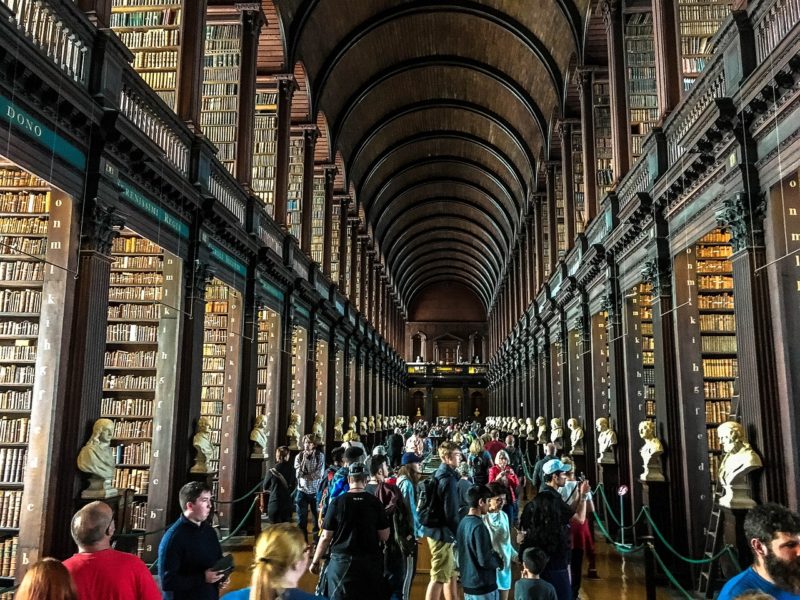
By May S. Ruiz
Summer this year took me back to Europe, my favorite travel destination. I journeyed to Scotland for the third time on British Airways via Heathrow International in London, which is one of the busiest and most crowded airports in the world.
To avoid having to go through Heathrow again coming back, I decided to visit Ireland for a few days before heading home. From Edinburgh, I took an Aer Lingus flight and was in Dublin in an hour.
I have actually stepped foot on Dublin before now; four years ago I made a stop here for a few hours enroute to Switzerland. While enjoying a breakfast of a cup of hot coffee and pastry at the airport lounge, I glimpsed lush green foliage outside through the rain. It was absolutely picturesque and I resolved to come back one day to see more of the city. And this past August I did.
The name ‘Ireland’ is a derivation of the ancient Irish word ‘Eire’ meaning western. According to legend, the Irish believe their country is in the west, the last land before the vast Atlantic Ocean.
It is divided into the northern and southern parts.
Northern Ireland is one of four countries that make up the United Kingdom (the others are England, Scotland, and Wales). Its capital is Belfast and its currency is the British Pound Sterling.
The southern part is the Republic of Ireland, with Dublin as its capital and the Euro as its currency; this is the Ireland I visited. Dublin (Black Pool), Ireland’s most important city, has been the capital and its major cultural and economic center since the early Middle Ages.
I was going to be here for only three nights so I limited my exploration of this land of leprechauns and shamrocks to Dublin. As in all my travels, I tend to see castles, cathedrals, and universities. And the capital has all three in close proximity to each other.
Being an education writer, I was very much interested in seeing for myself Trinity College, the University of Dublin, on College Green. It is the oldest university in Ireland and one of the oldest in Europe. I really wanted to learn as much as I could about the school so I joined a tour being given by a pleasant English graduate student.
Founded by Queen Elizabeth I in 1592 as ‘The College of the Holy and Undivided Trinity near Dublin’, its mission was to ‘promote civility, learning, and Protestant piety among the youth of Ireland’.
Due to some confusion in the Latin phrase used in the foundation document, the terms ‘University of Dublin’ and ‘Trinity College’ became synonymous. The explanation is that the University of Dublin consists of only one college: Trinity.
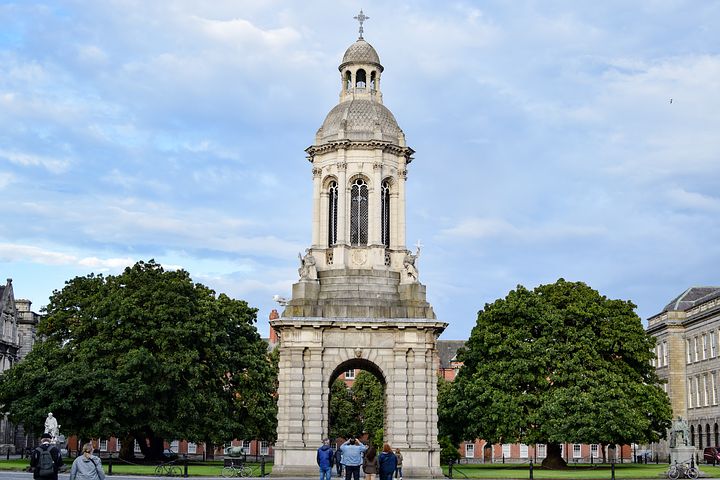
A majestic Campanile welcomes students and visitors to its beautiful campus. Flanking the Campanile’s rear are two Oregon maple trees, which were reportedly planted before 1850 from original seeds that were presumably taken back from the New World.
A life-size statue in marble of George Salmon, provost of Trinity College from 1888 to 1904, occupies a prominent space close to the Campanile. His 14 years as provost are described as ‘the golden years’ of Trinity.
According to our learned guide, Salmon is also known as the champion of women, a dubious honor since he apparently opposed the admission of women into the university having pronounced ‘Women would enter the college over my dead body’.
It is ironic that while it was founded by a woman, Trinity College was one of the last in the British Isles to admit women students. It was only in 1892 when 10,000 Irish women signed a petition to give women the same benefits and rights as have been conferred to men that the school finally gave in to pressure. Ireland’s 7th and 8th presidents, and its only two female presidents, Mary Robinson and Mary McAleese, were both Trinity alumnae. Today women constitute 58% of the student body.
Some of the most well-regarded luminaries in the world are graduates of Trinity College: Jonathan Swift, known as the author of Gulliver’s Travels, who later moved to London and got involved in English politics and then was appointed Dean of Saint Patrick’s Cathedral; Samuel Beckett, the acclaimed Pulitzer Prize-winning playwright of ‘Waiting for Godot’ and one of the most influential writers of the 20th century; Edmund Burke, who is best remembered as an early supporter of the American Revolution; to mention just three.
But there’s one name that ought to ring a bell to Californians – that of George Berkeley. He was a philosopher and later became Bishop of Cloyne. His many accomplishments are commemorated at Trinity College with a Berkeley Library and in California with an eponymous city – home of the University of California, Berkeley which has a Sather Tower that’s known as the Campanile. (At this juncture our tour guide noted that it is pronounced Bark-ley, but became Berk-ley in the United States. He also mentioned that, coincidentally, he is here pursuing his doctorate on George Berkeley’s life.)
My main goal in visiting Trinity College was to see the Old Library Building. It houses the Long Room, which may be the most gorgeous and most photographed library in the word, and the Book of Kells.
Called the Long Room because it is the longest single-room library in Europe, at 65 meters in length, it contains over 200,000 of some of the oldest volumes in the library. It is an amazing sight to behold! It is a working library and because the books there are rare, trained staff process requests from readers. Books are then brought to a specific area and care taken so their bindings are not stressed.
However, as in everything nowadays, technology will soon replace actual books being taken out and read – they are currently being scanned for online access. But that just ruins the whole experience, doesn’t it? There is nothing more thrilling for a bibliophile like me, than to hold one in my hands, smell the old leather, turn the fragile pages, and peruse the words written hundreds of years before my time.
The Book of Kells, also known as the Book of Columba, is an illuminated manuscript done in the Insular style. Containing the four Gospels of the New Testament, it is a masterpiece of Western calligraphy and an exemplar of insular illumination. It is regarded as Ireland’s greatest treasure.

A tour of Dublin would never be complete without a visit to Saint Patrick’s Cathedral, the patron saint of Ireland. Built by Luke, Archbishop of Dublin, between 1220-1259, on the site of an ancient well which was reported to have been used by Saint Patrick himself, the cathedral was made from local limestone and stone imported from Bristol.
Constructed like a cruciform, Saint Patrick’s Cathedral’s nave resembles the long part of the cross; the Choir, the top of the cross; and the transepts, the arms of the cross. Its design is thought to be based on Old Sarum Cathedral, near Salisbury, England.
Having visited the Cathedral of St. Patrick, the magnificent landmark Neo-Gothic-style Roman Catholic church on Fifth Avenue in New York City, I thought the Dublin cathedral appeared like a humbler version.
Saint Patrick’s Cathedral in Dublin is still a place of worship today. However, it is also very much a tourist stop, with kiosks selling all manner of souvenir spread throughout the nave. Standing near the apse, I found it difficult to think of Christian values when commercialism was on full display a few feet away.
The next place I went to was Dublin Castle on the city center off Dame Street. Built in 1204 on the orders of King John of England on a spot previously settled by the Vikings, it features a typical Norman courtyard design. It has a central square and is bounded on all sides by tall defensive walls and protected at each corner by a circular tower.
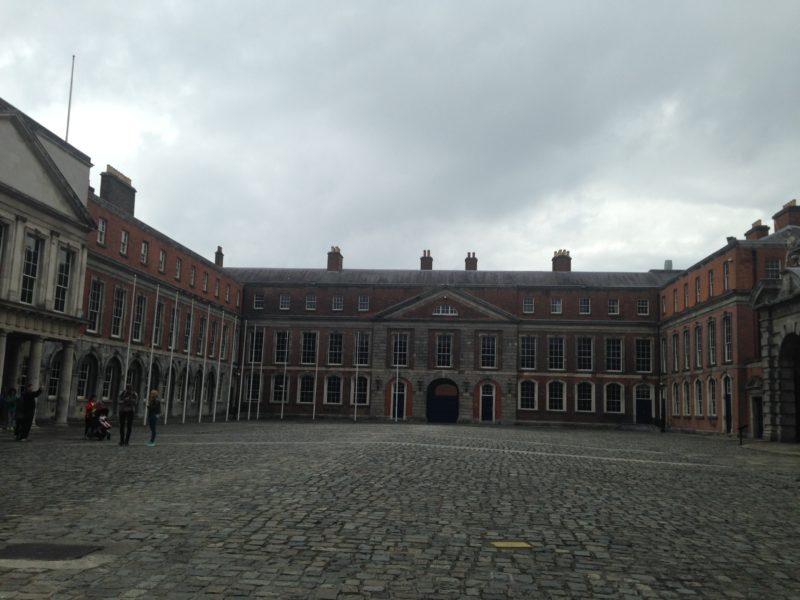
My tour consisted of visiting the state apartments and exhibitions. Saint Patrick’s Hall is the grandest room of the state apartments – it has one of the most important decorative interiors in Ireland. Its most striking feature is a painted ceiling by Vincenzo Valdre. Composed of three panels, it depicts the coronation of King George III, Saint Patrick introducing Christianity to Ireland, and King Henry II receiving the submission of the Irish chieftains. The room is used to this day for presidential inaugurations.
Other rooms worth seeing are: the throne room; the state drawing room; the dining room; and the Wedgwood room.
The most architectural space of the state apartments is the state corridor based on the early 18th century corridor of Edward Lovett Pearce in the former Parliament House on College Green. It showcases a marching procession of top-lit vaults and arches.
While it is an historic tourist attraction, Dublin Castle is a working Irish government building. It is used for state dinners, the most recent one being for Queen Elizabeth when she visited Ireland in 2011. It also hosts conferences.
Next on my walking tour was Dublin City Hall, located on Dame Street, next to Dublin Castle and five minutes away from Trinity College. Constructed between 1769 and 1779 by Thomas Cooley, a young architect from London, the City Hall was originally intended to be the Royal Exchange.
An impressive example of Georgian architecture, for which Dublin is world-renowned, the City Hall has a central entrance hall or rotunda, with a large dome supported by twelve columns. A floor mosaic showing the city arms and motto and marble statues of prominent Irish men grace the rotunda. Today it is used for corporate events and functions.
Not having much time left to enjoy other attractions, I opted to see the rest of the city from the comfort of a city tour bus. Our tour guide was Kiernan, a Dubliner, who gave the most insightful commentary about each stop. I will mention a few places I found personally notable.
Kiernan pointed out that it is almost inconceivable that such a small island could produce so many exceptional scholars and writers, especially when Ireland is perceived as a geographical backwater on the farthest edge of Europe. The Irish pride in their intellectuals is celebrated in the Dublin Writers Museum on Parnell Square North. This restored 18th century building is domicile to letters, books, and other memorabilia of Ireland’s greatest writers – George Bernard Shaw, William Butler Yeats, Samuel Beckett, Oscar Wilde, James Joyce, and Brendan Behan.
Dublin may very well be the only two-Cathedral city anywhere. Saint Patrick’s is the National Cathedral for the Church of Ireland community; and the First Church Cathedral – the original Cathedral of Norse – is the cathedral for the diocese of Dublin and Glendalough, and the seat of the bishop.
Mansion House on Dawson Street has been the official residence of the Lord Mayor of Dublin since 1715. The Round Room to the left of the main building is where the Irish Parliament met in 1919.
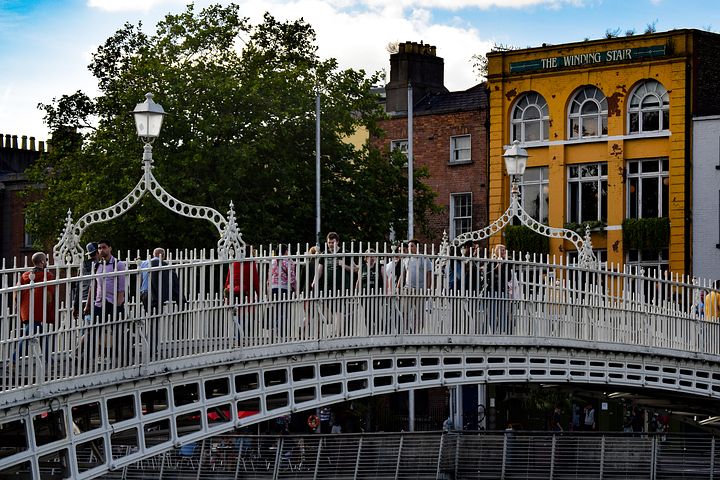
One of Dublin’s most famous attractions is the Guinness Storehouse. Tourists come here to see the site where Arthur Guinness started brewing the drink that bears his name. The highlight of one’s visit is the Gravity Bar where one can see the entire city while imbibing a complimentary pint.
The Irish are also famous for their whiskies. They claim that whiskey was first distilled in Ireland (having just visited Scotland, where, the Scots assert, whisky originated, I found this rather amusing. That they cannot agree on the matter is further reflected in the way they spell the word. The Scottish spelling is whisky while the Irish spell it whiskey). Whiskey is the English translation for the Scottish Gaelic uisge or Irish Gaelic uisce, meaning ‘water of life’.
Celtic Whiskey on 27 Dawson Street does not discriminate; it boasts the most comprehensive range of the drink with Irish, Scotch, and whiskies from around the world. It is staffed with afionadoes who can tell buyers everything they want to know about whiskey.
Teeling Whiskey Distillery on Newmarket Square is the only operational distillery in Dublin. Here visitors can watch the traditional Irish whiskey process.
Jameson Distillery, Bow Street, Smithfield Village offers upbeat and informative tours by personal guides who take visitors from grain to glass. Guided tours, whiskey masterclasses, and premium tasting are available. The tour ends at the gift shop where buyers can purchase a personalized bottle or a memento of their visit.
Grafton Street is Dublin’s premier shopping area. It is also a social and cultural district where buskers and entertainers can be found at all hours of the day.
Ireland’s widest and most famous street is O’Connell St which has been the setting of pivotal events in its history. It is lined with statues commemorating Irish heroes including Daniel O’Connell and Jim Larkin, the central figure in Dublin’s lockout. Here is also where one can find the spire of Dublin, a pin-like monument over 120 meters high.
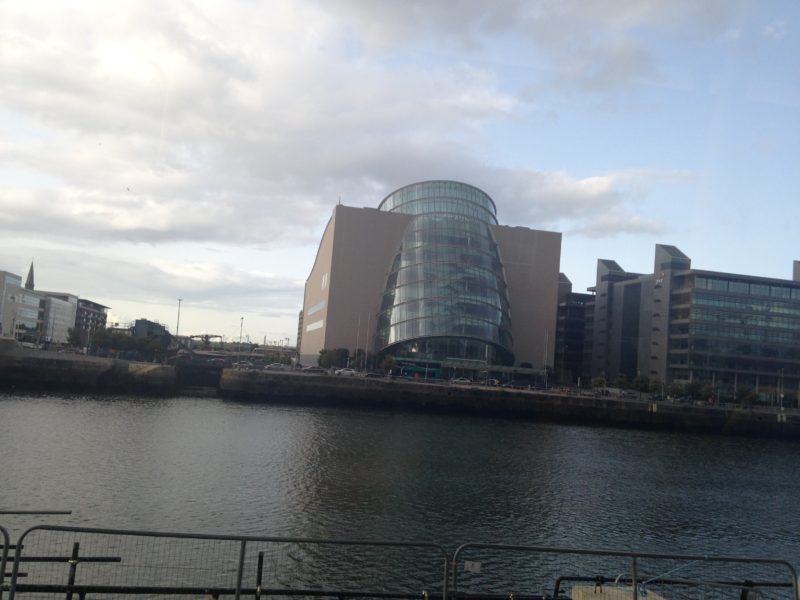
Dublin is a city of many contrasts. The classic and stately Custom House stands not too far from the carbon neutral-constructed Convention Centre, Dublin, utterly striking in its modernity. The Ha’penny, the iconic iron pedestrian bridge crosses The River Liffey on Aston Quay, while a mile away in the Docklands area there’s the cable-stayed Samuel Beckett Bridge, a stunning masterpiece of structural engineering. Pubs which characterize old stereotypes of Irish culture are mainstays even as ubiquitous stores the likes of Abercrombie & Fitch, Gucci, H&M, and Louis Vuitton flourish, evidence of a cosmopolitan city.
Through it all, you can see that Ireland is a welcoming country. Dubliners are gregarious by nature and are quick to talk to strangers about their infamous weather (it rains at the drop of a hat and stops just as abruptly as it starts). They are happy to give you directions when you’re getting lost (they conjecture their early street designers were probably affected by Guinness fumes). They go about their daily life with an ease reflective of their country’s unspoiled beauty.
Everywhere you go, you observe young people with backpacks slung on their shoulder and earbuds attached to their iPhones walking alongside their older briefcase-carrying counterparts looking down on their smartphones, ready to begin their day. Today’s Dublin feels contemporary and vibrant – it is a city at once in touch with its historic past and set to embark on a promising future.

